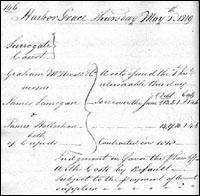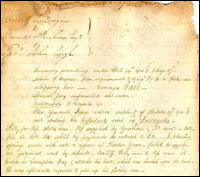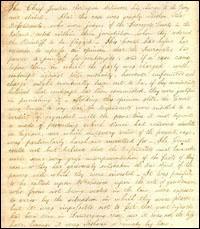
|
A Cautious Beginning: The Court of Civil Jurisdiction 1791 by Christopher English and Christopher Curran The Judicature Act, 1791: A Framework for the Future For the first time provision was clearly made for the settlement of debts. In the event of insolvency "the goods, debts, and credits of any person shall be attached". If restitution was not made voluntarily the court, after a hearing, could so order out of the proceeds of sale. Distribution would be on a rateable basis among the creditors (s. 6), except for the seaman and fisherman's traditional first lien "for wages [which] become due in the current season" (s. 7). Next in line came "creditor[s] for supplies furnished in the current season". In this case the key qualifying phrase "for the fishery" did not occur, the subject of considerable litigation in the years after 1815. This qualification was held by Chief Justice Francis Forbes39 to be implied in light of the third priority of claimant: "and lastly, the said creditors for supplies furnished in the then current season and all other creditors whatever". The 1791 Act's provision for shutting off claims was refined. If an insolvent made full disclosure, with the court's consent and that of "one half in number and value of . . . [the] creditors", a certificate would bar further claims (s. 8). Any action which arose before 1 August 1792 must be brought within six years; otherwise the limitation period was narrowed to six months.
The Supreme and Surrogate Courts would exercise exclusive civil jurisdiction, "any law, custom or usage to the contrary notwithstanding". Admiralty's traditional jurisdiction over "maritime causes . . . and causes on the revenue" remained, but it was barred from hearing actions on seamen's wages (s. 12). Claims under 40 shillings in tort or contract for wages could be heard before Sessions Courts of two justices of the peace, neither of whom could now be customs officers. They exercised a summary jurisdiction intended to deal with the payment of debts within a year of the cause of action arising. Blending law and equity in the Supreme Court almost a century before such was achieved in England in 1875, the Chief Justice could award costs and execute by attachment; his decision was final; and he had sole jurisdiction over intestacy and probate (ss. 12, 13, 10). He oversaw the sheriff, and the procedures, rules and fees of all four levels of Court40 with an eye to "expediting matters with the most convenience and least expense to the parties" (s. 14). All Courts could grant summary execution for fees and costs (s. 15) which remained the sole source of revenue to run the judicial system. In keeping with the Act's intention to rationalize and expedite the delivery of justice plaintiffs were on notice to mount a good cause of action. If judgment issued for the defendant, or if the plaintiff was non-suited or discontinued his action after the defendant had filed an appearance, the defendant recovered triple costs without prejudice to any other legal remedy (s. 16).
Finally, caution remained paramount. Like its predecessor of 1791 the Act had to be renewed annually until, slightly amended, it was made permanent in 1809.41 Evidently the progress of the new regime was carefully monitored. In his report on his second season in Newfoundland in 1792 Reeves spent a good deal of time on the problem of how to assure the independence of the magistrates in the outports. The local merchant appeared all-powerful. The doctor was usually on a retainer from him. Who else was available? Although there were only five Anglican clergymen on the island, most of them representatives of the Society for the Propagation of the Gospel, Reeves suggested that their £70 per annum salaries be supplemented by £100 to assure their independence. In a revealing aside he noted that without such independent justices " 15 Geo. III [c.31] will remain a dead letter, as it hitherto has been". Here was a clear reflection of the official mind-set of the policy makers and those called upon to put it in practice. The line of continuity stretched from 1792 back through 1791, itself a revision of 1775, which in turn drew its inspiration and policy priorities from 1699.
|
||||||||||||||||||||
 |
||||||||||||||||||||


